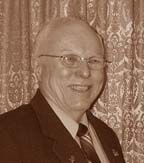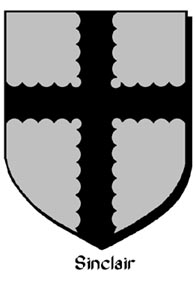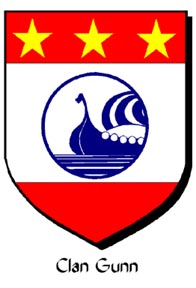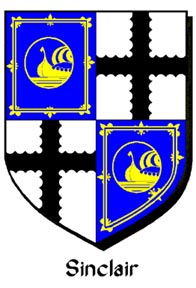Henry Sinclair, 1st Earl of
Orkney
also referred to as:
"Prince" Henry Sinclair, Earl of Orkney
 This page was set up by Robert Sewell in April 2002 to show the descent
of Henry Sinclair, Earl of Orkney, who is reputed to have sailed to North
America 100 years before the voyages of Christopher Columbus. Robert
Sewell graduated from McMaster University (Hamilton, Ontario, Canada) in
1967 with a B.Sc. degree in chemistry. After a year of studies at
the University of Toronto's College of Education, he taught high school
science in Collingwood, Ontario for a year and then taught chemistry, physics
and general science in Hamilton, Ontario for twenty-nine years. Robert
Sewell retired from teaching in June 1998. He may be contacted by
email from September to May at the following address:
This page was set up by Robert Sewell in April 2002 to show the descent
of Henry Sinclair, Earl of Orkney, who is reputed to have sailed to North
America 100 years before the voyages of Christopher Columbus. Robert
Sewell graduated from McMaster University (Hamilton, Ontario, Canada) in
1967 with a B.Sc. degree in chemistry. After a year of studies at
the University of Toronto's College of Education, he taught high school
science in Collingwood, Ontario for a year and then taught chemistry, physics
and general science in Hamilton, Ontario for twenty-nine years. Robert
Sewell retired from teaching in June 1998. He may be contacted by
email from September to May at the following address:
Click
to Contact Robert Sewell
Please visit the Sewell
Genealogy Site Map for other pages in this series.
Contents
Henry Sinclair
The Legendary Voyages
Ancestors of Henry Sinclair
Descendants of Henry Sinclair
Sources
Henry Sinclair, 1st Earl of Orkney

Henry Sinclair is reputed to have
been born about 1345, and was proclaimed Lord of Rosslyn upon the death
of his father in 1358. Henry married first to a granddaughter of
the King of Norway and Sweden, but she died shortly thereafter before they
had any children. On the death of his maternal grandfather, Malise,
Earl of Stratherne, Orkney, and Caithness he became one of the competitors
for the earldom of Orkney, the others being his cousins, Aleander
del Ard and Malise
Sperra, Lord of Skaldale. These three proceeded to Norway, where, having
submitted thier claims to King Hakon VI, he, at Marstrand on August 2,
1379 formally invested Henry as Earl of Orkney and Lord of Shetland, under
certain restrictions. The Earl was to govern the islands and to enjoy the
revenues during the King's pleasure, but was not to build any castles,
and was to be answerable to the King's Court at Bergen. At his death
the earldom was to revert to the Crown of Norway if he left no sons, and
if he did they were to be re-invested. In defiance of the terms of his
charter he built the Castle of Kirkwall. Henry had a charter from
King Robert III of the castlewards of Pentland and Roslin, built the dungeons
of Roslin and certain walls thereabout, and laid out parks for fallow and
red deer.
In 1389 Henry attended the coronation
of King Eric of Norway. In 1391 he was engaged in the conquest of
the Færoe Isles, and at this point legend becomes mixed with history.
Henry is said to have met the Venetian voyager Nicolò Zeno, who
happened to be wrecked there, and was appointed by Henry to be captain
of his fleet. Having conquered the Færoes, he next descended
on Shetland, where Malise Sperra had established himself, and with the
assistance of Zeno, Sperra was defeated and slain with seven of his followers
near Tingwall. With the brothers Antonio and Nicolò Zeno,
Henry is next reputed to have set out to discover a rich and populous country
in the far west which had been stated to exist by fishermen, who alleged
they had been driven there by a storm. Encountering fog they drifted
south to the west of Ireland and landed at Icara (Kerry), from whence they
sailed north-west and, according to legend, came to Greenland.
It is entirely possible that Henry
Sinclair visited Greenland about 1392 at which time there may have been
some Norse colonies there, although they would most definitely have been
in a state of decline. The last Bishop of Greenland known to have
visited his see died in 1372. Henricus (Erik) was consecrated as
Bishop of Greenland in 1389, but there is no record of him ever finding
a ship to take him there. A ship from Norway spent a winter at an
abandoned Greenland settlement circa 1406 - 1410 and found only wild cattle
and no people. Unfortunately, there is no actual historical record
or evidence of Henry Sinclair having visited Greenland, and we can only
say that he is reputed to have done so and that such a voyage would have
been quite possible.
As Earl of Orkney, Henry was entitled
to impose taxes and wear a crown if he chose to do so. Because of
this, he is referred to as "Prince Henry Sinclair, Earl of Orkney", although
it appears that he was never actually granted the title of Prince.
Regardless, he was a vassal of the Kings of both Scotland and Norway, and
was a man of considerable wealth and power with his own fleet of 13 ships
that plied between Norway, the Orkneys and Rosslyn. He was also the
Duke of Oldenburg in Denmark, Admiral of the High Seas for Scotland and
Lord Chief Justice of Scotland.
Henry Sinclair was slain circa 1400
- 1404. An English expedition was sent to conquer the Orkneys in
August 1400, and he may have been slain by the English invaders around
that time. Scot's Peerage states: ". . . he was
slain in 1404, while resisting an invasion from the south." (Vol. VI, page
569)
The Legendary Voyages
Henry Sinclair is alleged to have left
the Orkneys in early April 1397 or 1398 with 12 or 13 ships and journeyed
to what is now Newfoundland and Nova Scotia. Most of the ships then returned
to the Orkneys; but two remained in the New World, journeyed on to Massachusetts
and Rhode Island, and returned the next year. Some details of this
legend are as follows:
The Zeno Brothers: The
Venetian brothers Nicolò and Antonio Zeno were ship wrecked on the
Island of Frislanda (thought to be The Færoes) where the local prince
named Zichmni (thought to be Henry Sinclair) is said to have hired one
or both of them as navigators or admirals. The Zeno brothers sent
a record of this voyage including the famous "Zeno Map" back to a third
brother Carlo "the Lion" Zeno in Venice. Regardless of their exact
role, the Zeno Brothers are a part of the legend. The Zeno Map and
manuscript relating the details of the voyage were kept secret until 1558
when a descendant, also named Nicolò, decided to make a printed
book of it.
It has also been suggested that Zichmni
was a Baltic pirate named Wichmann and that the Zeno brothers were involved
in pirating when they were supposed to have been exploring and map making.
For more on the Zeno Brothers and their map, please see:
The Zeno Map at: http://www.pibburns.com/mewhinne/5a-1.htm
Newfoundland: They landed,
but were attacked and driven off by native people. They managed to
replenish their food, water and wood supplies at a nearby site, but were
once again driven off and a number of men were killed.
Visitors recently returned from Newfoundland
report that the hospitality displayed by the inhabitants of that province
in the early 21st century has improved dramatically since the late 14th
century.
Nova Scotia: They landed
in Nova Scotia in late May or early June and found the native Micmac Indians
friendly. Henry Sinclair became known as "Glooscap", the white Micmac god.
He built a castle and buried the Holy Grail (and perhaps the Arc of the
Covenant as well) in a mysterious deep shaft on Oak Island. All except
two ships returned to the Orkneys, and Henry Sinclair wintered in Nova
Scotia during which time he and his men built a larger ship . . . or so
the story goes.
 Massachusetts
and the Westford Knight: Next spring, Henry
Sinclair and his men sailed south and landed in Massachusetts. At
that point, Sir James Gunn died and a memorial was inscribed on a rock
on Prospect Hill in Westford, Massachusetts. This memorial is described
by some as nothing more than a crudely pecked outline of an 18th century
tomahawk while other describe it as a Knight Templar in armour carrying
a sword and a shield bearing the arms of the Clan Gunn.
Massachusetts
and the Westford Knight: Next spring, Henry
Sinclair and his men sailed south and landed in Massachusetts. At
that point, Sir James Gunn died and a memorial was inscribed on a rock
on Prospect Hill in Westford, Massachusetts. This memorial is described
by some as nothing more than a crudely pecked outline of an 18th century
tomahawk while other describe it as a Knight Templar in armour carrying
a sword and a shield bearing the arms of the Clan Gunn.
For more about the Westford Knight,
please see:
The Westford Knight: Tracing of the Rock Effigy
at: http://sinclair.quarterman.org/sinclair/effigy.html
Rhode Island and the Newport Tower:
Later the same year, Henry Sinclair is reputed to have sailed on to Rhode
Island where he built the mysterious Newport Tower, which is also said
to have been built by the Vikings in the 11th century and by Portuguese
explorers in 1511.
The best evidence, supported by radioisotope
dating, suggests that the Newport Tower was built as a windmill during
the 17th century.
For more about the Newport Tower, please
see:
Newport's Mystery Tower at: http://www.unexplainedearth.com/newport.php
Ancestors of Henry Sinclair
The following record is based on Sir James Balfour Paul's
The
Scot's Peerage, Vol. VI, pp. 564 - 571; except where stated otherwise.
|
SINCLAIR, EARL OF ORKNEY
|
| I. Robert de Saint Clair, in Normandy, married Eleanor de Dreux,
relict (widow) of Hugh, Lord Chateauneuf and daughter of Robert, second
Count de Dreux, in France, by Joland de Coucy, his wife. Sir Robert had
issue:
|
II. Sir William Sinclair was Sheriff of Edinburgh 1266, 1288-90;
of Haddington 1264-90; Linlithgow 1264-90; Dumfries 1288; and Justiciar
of Galwythie 1288-89. He was guardian to Alexander, Prince of Scotland,
1279-81 who predeceased his father in 1283-84. Was granted a Charter
by King Alexander III, on April 8, 1280, of the baxter (border) lands of
Innerleith, and a charter of the lands and barony of Roslin, on September
14, 1280. He was one of the garrison who defended the Castle of Dunbar
in 1296 against Edward I, and on its surrender , on March 25, 1296, was
sent a prisoner in the Tower of London.
Sir William Sinclair is said to have married Agnes,
who may have been a daughter of Patrick, Earl of Dunbar. Agnes may or may
not be the same person as Amicia, described as a "widow of William St.
Clair, dwelling in the county of Edinburgh" who had a two years protection
from Edward I. on April 7, 1299. Sir William had issue:
-
Sir Henry, shown next.
-
William, who succeeded Matthew do Crambeth as Bishop of Dunkeld
in 1312.
-
Annabel, who married first to Sir Robert Bisset, and secondly to
Sir David Wemyss.
-
Gregory (perhaps) who is said to the be the ancestor of the Longformascus
family.
Note: Thanks to W. Darcy
McKeough who has shared a report by James Dinwoodie, Scots Ancestry Researcher,
which states: "In 1162, in the reign of King Malcolm IV, the Norman knight
Sir Henry de Sainte Claire settled in Lothian. It was not until 1280,
in the reign of Alexander III that Henry's great great grandson Sir William
de St. Clair was granted the lands of Rosslynn or Roslin in Lothian five
miles south of Edinburgh."
|
III. Sir Henry St. Clair of Roslin swore fealty to Edward I
on 13 June 13, 1292. However, he was one of the garrison of Dunbar Castle,
where he was taken prisoner in 1296 and sent to England. He was exchanged
in 1299; and about September 15, 1305 was appointed Sheriff of Lanark by
Edward I. Sir Henry appears to have switched sided frequently; he eventually
supported the Bruce, and fought against the English at Bannockburn.
On October 21, 1314, Sir Henry had a Charter from
King Robert, of all His Majesty’s lands on the Muir of Pentland, and a
further Charter from Edward de Gourton of the part of the lands of Gourton,
tenanted by Roger de Hauewood, dated the Friday after the feast of St.
Bartholomew, August 28, 1317. He was one of the Barons of Scotland,
who signed the letter dated April 4, 1320 to Pope John XXII, asserting
the independence of Scotland.
Sir Henry married Alice de Fenton who survived him.
He died before January 28, 1335/36; and left issue:
-
Sir William, shown next.
-
John, who accompanied his brother Sir William on the expedition
to the Holy Land with the heart of Bruce. He was murdered, as was his brother,
by the Saracens in Andalusia, Spain, on August 25, 1330.
|
IV. Sir William St. Clair had a grant of a pension of £40
in anticipation of his services in the Holy Land 1329, being one of the
knights chosen to accompany Sir James Douglas to Palestine with the heart
of Bruce, but was murdered, as was his brother, by the Saracens in Andalusia,
Spain on August 25, 1330. He left issue:
-
William, shown next.
-
Margaret, who married first to Thomas Stewart, Earl of Angus who
died in 1361 and secondly to Sir John Sinclair of Hermandston.
-
Thomas (perhaps) who was Bailie of Orkney for the King of Norway
and left a son:
-
John (perhaps) who was a witness in 1367.
Note: According to Florence Van
Rensselaer: The Livingston Family in America and Its Scottish Origins:
New York, 1949, page 26; Sir William St. Clair was "a Baron of Normandy"
who "married a daughter of Richard, Duke of Normandy." |
V. William Sinclair of Roslin was a minor when his father died,
and succeeded to the pensions of his father and his Uncle John. He
had a Charter from King David II of the lands of Morton and Merchamyston
in Midlothian, on the resignation of William Bisset on February 10, 1357/58.
He had a safe conduct to go to England on May 6, 1358 on his way abroad
to Prussia to fight in foreign wars. On September 17, 1358 King David
II confirmed to him an annuity granted to his grandfather Sir Henry
S. Clair.
William married Isabella, second daughter of Malise,
8th Earl of Strathearn, Earl of Orkney and Caithness and his wife Marjorie,
a daughter of Hugh, 4th Earl of Ross and Lady
Maud Bruce, a sister of Scotland's national hero, King Robert the Bruce.
Marjorie was a sister of William, 5th Earl of Ross. William Sinclair left
issue:
-
Henry, shown next.
-
David, who had a charter under the Great Seal of the lands of Newburgh
and Auchdale in Aberdeenshire in exchange for any rights which he had in
Orkney and Shetland, derived from his mother, dated April 23, 1391.
|
VI. Henry Sinclair, 1st Earl of Orkney, the main subject of
this page. He was born circa 1345 and died (slain) circa 1400 - 1404. He
married circa 1370-74 to Jean Haliburton, daughter of either Sir
Walter Halyburton of Dirleton or Sir John de Halyburton of Dirleton and
his wife Margaret Cameron.
(please see below)
Henry was invested Earl of Orkney and Lord Zetland,
by King Haakon of Norway, at Marstrand, Norway on August 2, 1369. According
to legend, he visited Greenland and North America in 1390's. |

Henry Sinclair and his descendants
Generation One
Henry Sinclair, 1st Earl of Orkney
Born circa 1345
Acceded on the death of his father in 1358 when he was
only 13 years old
Died (slain) circa 1400 - 1404
According to legend, Henry Sinclair visited Greenland
circa 1391/92. He is also reputed to have voyaged to what is now
Newfoundland, Nova Scotia, Massachusetts and Rhode Island circa 1398.
According to Sir John Balfour Paul: The Scots
Peerage, 1904 - 1914, Vol. VI, p. 569, Henry Sinclair married to
Jean Halyburton, a daughter of Sir Walter Halyburton of Dirleton.
According to Florence Van Rensselaer: The Livingston
Family in America, New York, 1949, pg. 28, Henry Sinclair married
circa 1370 -1374 to Jean de Haliburton, a daughter of Sir John de Haliburton
of Dirleton and Margaret Cameron. Sir John was a son of Sir Walter Halyburton.
Ms. Van Rensselaer gives as her reference Sir James Balfour Paul:
The Scots Peerage, 1904 - 1914, Vol. IV, pp. 330 - 338; corrections
in Vol. IX, p. 102.
Regardless of Jean's exact parentage, she and Henry had
the following children:
-
Henry Sinclair, 2nd Earl of Orkney,
born circa 1375, died on February 1, 1420. Henry married Egidia Douglas,
a daughter of Sir William Douglas of Nithdale who was a son of Archibald
"the Grim", 3rd Earl of Douglas. Egidia
Douglas was a granddaughter of King Robert II of Scotland. Henry and
Egidia had issue:
-
William Sinclair, 3rd Earl of Orkney who married Elizabeth
Douglas, a daughter of Archibald Tyneman, 4th Earl of Douglas who was a
son of Archibald "the Grim", 3rd Earl of Douglas. Thus, William (3rd
Earl of Orkney) and his father Henry (2nd Earl of Orkney) both married
granddaughters of Archibald "the Grim", 3rd Earl of Douglas.
-
Beatrix Sinclair, shown below. According to The Scots Peerage,
Vol. VI, pg. 571, Beatrix was a daughter of Henry Sinclair, 2nd Earl of
Orkney. Please click HERE
to see why I think this is incorrect.
-
John Sinclair who is said to have married Ingeborg, a natural
daughter of Waldemar, King of Denmark by Jova Little.
-
William Sinclair.
-
Elizabeth Sinclair who married Sir John Drummond of Cargill.
-
Margaret Sinclair who married James of Cragy, Laird of Hupe
in Orkney.
-
Jean Sinclair who married Sir John Forrester of Corstorphine.
-
a daughter who married Cockburn of Skirling.
-
a daughter who married Heron of Marieton.
-
Mary Sinclair who married Thomas Somerville of Carnwath.
-
Marjory Sinclair who married Sir David Menzies of Weem.
-
Beatrix Sinclair, shown next under Generation
Two, who was probably the youngest daughter (perhaps posthumous) of
Henry Sinclair, 1st Earl of Orkney.
| At this point, we have a conundrum.
Was Beatrix a daughter of the 1st or 2nd Earl of Orkney? Beatrix is shown
in The Scots Peerage as a daughter of Henry Sinclair, 2nd
Earl of Orkney and his wife Egidia Douglas. When Beatrix married James
"the Gross", 7th Earl of Douglas, she would have been marrying her mother's
uncle. Beatrix would have been both a daughter-in-law and great granddaughter
of Archibald "the Grim", 3rd Earl of Douglas.
Please click HERE
to learn why this could not be so.
|
To further complicate this issue, it would
seem that Burke's Peerage, (Genealogical Books Ltd, 2003),
volume 1, page 438 shows another Beatrix or Beatrice Sinclair who married
Sir William Borthwick. I have not seen this edition of Burke's, but web
pages citing this and other references include:
-
thePeerage.com
where Beatrice's father is shown as the 1st Earl of Orkney and her mother
is not shown thereby introducing the possiblilty that this Beatrice may
have been a "natural" or illegitimate daughter of Henry Sinclair, 1st Earl
of Orkney.
-
Leo's
Genealogics Website where neither her mother nor father are shown.
|

|
I have shown Beatrix as a daughter of the 1st Earl
of Orkney.
However, I am open to suggestions.
Please send any information to Robert
Sewell
|
Generation Two
Lady Beatrix Sinclair
Born circa 1400 - 1404, perhaps after the death of her
father.
Died before February 8, 1462
Married before March 7, 1425 to James "the Gross", 7th
Earl of Douglas, a son of Archibald "the Grim", 3rd Earl of Douglas.
Sir James Douglas was of Balvany in Banffshire, and was created Earl of
Avondale and Lord Balvany before becoming the 7th Earl
of Douglas.
Beatrix and James had the following children:
-
William, 8th Earl of Douglas
-
James, 9th Earl of Douglas
-
Archibald Douglas, Earl of Moray
-
Hugh Douglas, Earl of Ormond
-
John Douglas, Lord of Balveny
-
Janet Douglas
-
Margaret Douglas
-
Beatrice Douglas
-
Henry Douglas, In Holy Orders
-
George Douglas
Genertion Three
Lady Janet Douglas
Married before 1451 to Robert, 1st Lord Fleming, a son
of Sir Malcolm Fleming and Elizabeth Stewart who was a granddaughter of
King Robert II of Scotland.
Janet and Robert had the following daughter:
-
Beatrice Fleming who married Sir James Livingston,
3rd Lord Livingston of Callendar.
For Beatrice Fleming's descent from the Kings of
Scotland
through her father, Robert, 1st Lord Fleming,
click on The
Kings of Scotland Page.
Generation Four
Beatrice Fleming
Beatrice married to James Livington 3rd Lord Livingston
of Callendar and they had a son:
-
William Livingston, 4th Lord Livingston of Callendar
For the continuation of this line, click on Livingston
of Callendar
Sources
Sources used for this page include the various internet
links given throughout the page as well as:
Sewell Vincent Sample: Letters, 2002.
Samuel Eliot Morison: The European Discovery of
America, New York, 1971.
Florence Van Rensselaer: The Livingston Family
in America, New York, 1949.
Sir James Balfour Paul: The Scots Peerage,
1904 - 1914, Vol. VI, pp. 564 - 571.
Brian Tompsett: Royal Genealogy at: http://www.hull.ac.uk/php/cssbct/genealogy/royal/
For another story of pre-Columbian discovery of
North America,
click on Prince
Madoc.
|
Please visit the Sewell
Genealogy Site Map for other pages in this series.
return to the top
 This page was set up by Robert Sewell in April 2002 to show the descent
of Henry Sinclair, Earl of Orkney, who is reputed to have sailed to North
America 100 years before the voyages of Christopher Columbus. Robert
Sewell graduated from McMaster University (Hamilton, Ontario, Canada) in
1967 with a B.Sc. degree in chemistry. After a year of studies at
the University of Toronto's College of Education, he taught high school
science in Collingwood, Ontario for a year and then taught chemistry, physics
and general science in Hamilton, Ontario for twenty-nine years. Robert
Sewell retired from teaching in June 1998. He may be contacted by
email from September to May at the following address:
This page was set up by Robert Sewell in April 2002 to show the descent
of Henry Sinclair, Earl of Orkney, who is reputed to have sailed to North
America 100 years before the voyages of Christopher Columbus. Robert
Sewell graduated from McMaster University (Hamilton, Ontario, Canada) in
1967 with a B.Sc. degree in chemistry. After a year of studies at
the University of Toronto's College of Education, he taught high school
science in Collingwood, Ontario for a year and then taught chemistry, physics
and general science in Hamilton, Ontario for twenty-nine years. Robert
Sewell retired from teaching in June 1998. He may be contacted by
email from September to May at the following address:

 Massachusetts
and the Westford Knight: Next spring, Henry
Sinclair and his men sailed south and landed in Massachusetts. At
that point, Sir James Gunn died and a memorial was inscribed on a rock
on Prospect Hill in Westford, Massachusetts. This memorial is described
by some as nothing more than a crudely pecked outline of an 18th century
tomahawk while other describe it as a Knight Templar in armour carrying
a sword and a shield bearing the arms of the Clan Gunn.
Massachusetts
and the Westford Knight: Next spring, Henry
Sinclair and his men sailed south and landed in Massachusetts. At
that point, Sir James Gunn died and a memorial was inscribed on a rock
on Prospect Hill in Westford, Massachusetts. This memorial is described
by some as nothing more than a crudely pecked outline of an 18th century
tomahawk while other describe it as a Knight Templar in armour carrying
a sword and a shield bearing the arms of the Clan Gunn.


